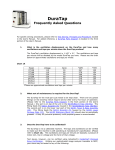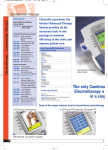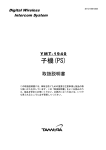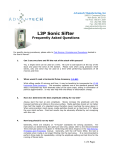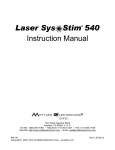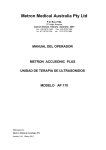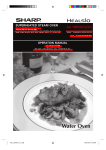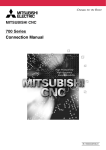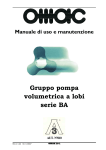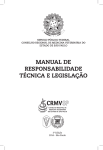Download DuraTap™ Testing Sieve Shaker
Transcript
DuraTap TM Testing Sieve Shaker Operation & Set-up Manual Models: DT168 DT258 DT268 DT1612 DT2512 DT2612 Advantech Manufacturing, Inc. 2450 S Commerce Dr., New Berlin, WI 53151 USA Telephone: 262-786-1600 • (800) 511-2096 • Fax: 262-786-5074 E Mail: mailto:[email protected] • Web Site: www.advantechmfg.com A Product of the United States of America Introduction Thank you for selecting this high-quality piece of testing equipment. We appreciate your support and pledge to assist you in the service of your Advantech testing apparatus. The Advantech DuraTap™ is a low maintenance, heavy duty sieve shaker that will provide consistent, reliable performance. Gone are the days of needing to buy “accessory packs” of repair parts for expected breakdowns like other sieve shakers require. The DuraTap™ does not use typical plastic and wear-surface parts. This industrial-strength unit is engineered with rugged steel and alloy materials ready to withstand the everyday, harsh duty cycles. Grease fittings are provided to ensure longer life for your bearings. Each unit is “burned-in” guaranteeing performance right out of the box. This unit is ideal for use with aggregates, sands, cements, chemicals, powder metals, cosmetics, pharmaceuticals and many other dry components in pellet, ground, granular or powder form. This unit is not recommended for wet sieving operation. Besides the physical nuts and bolts, this device is backed by a company with decades of experience in the dedicated service of users in the powder and particulate industries. We look forward to servicing you as well. “The Leader in Sieving Technology ” ® Specifications Model Designations and Power Requirements •Model DT168 ............................... 110VAC/60Hz operation, 8” (203.2mm) diameter sieve capacity •Model DT268 ............................... 220VAC/60Hz operation, 8” (203.2mm) diameter sieve capacity •Model DT258 ............................... 220VAC/50Hz operation, 8” (203.2mm) diameter sieve capacity •Model DT1612 ............................. 110VAC/60Hz operation, 12” (304.8mm) diameter sieve capacity •Model DT2612 ............................. 220VAC/60Hz operation, 12” (304.8mm) diameter sieve capacity •Model DT2512 ............................. 220VAC/50Hz operation, 12” (304.8mm) diameter sieve capacity Timer •24 hours, reported accuracy +/- 2 seconds Dimensional Specifications •Unit base: 28” (71.1cm) L x 21” (53.cm) W x 25” (63.5cm) H General Specifications •Steel weldment base •Durable, baked epoxy finish •Unit capacity: 7 full height sieves with full height pan and cover 15 half height sieves with half height pan and cover Installation & Set-up Instructions The DuraTap™ Testing Sieve Shaker is designed to give years of trouble-free service. To assure that the device delivers optimum performance, several points must be observed before putting the device into service. 1) Mounting For best results, the unit must be permanently mounted. It is recommended that unit be bolted to a steel table, heavily constructed wooden bench or other suitable structure that will be able to withstand the vibratory and hammering action of the unit. The diagram below shows the location of bolt holes provided for the mounting. Use 3/8” diameter bolts (purchased locally) to secure the unit. Inspect the mounting periodically for loosening due to vibration. 2) Cleaning The unit is painted with a baked epoxy finish that will clean readily with a soft damp cloth. For best results, vacuum any loose particulate materials prior to wiping the machine clean. 3) Sieve Stack Height Adjustment To assure repeatable and reproducible results in testing, the drop of the hammer arm has been precalibrated during assembly. It is essential, however, that the stack of sieves be installed at the proper height to obtain optimal results. To adjust the sieve stack height, please observe the following: •Be sure the hammer lift rod is at the lowest point of travel •Load the stack of sieves, pan, cover and sieve cover with cork on to the sieve support plate •Loosen the two wing screws on the sieve support plate •Raise the sieve support plate along with the sieve stack until the hammer arm comes to an approximately level position (see diagram) •Tighten the wing screws and begin testing H amme r liSieve ft r od Siev e co v er wCork ith c or k Hammer Lift Rod Cover with Siev e su p po rt pla te w ith w in g sc re w s -9 0 ° 4) Lubrication Instructions This unit requires periodic lubrication at two different points in the mechanism. After every 5 hours of operation, apply any general-purpose grease containing graphite to the grease fitting at the rear of the top yoke. At the same time, apply grease to the bulkhead grease fitting located on the left side of the machine base. Wipe off excess grease before operating. Do not over apply grease. Performing a Sieve Analysis using the DuraTapTM Testing Sieve Shaker 1) Complete installation of the DuraTap™ Testing Sieve Shaker per instructions. 2) Plug device into the proper power source (be sure that voltage and cycle requirements are observed). 3) Prepare the material sample to be tested using industry-specified sampling and preparation procedures. 4) Select the sieves for the analysis. 5) Assemble the sieve stack, (coarsest sieve at the top, finest at the bottom) with bottom pan. 6) Pour the sample to be tested onto the top sieve. Install a standard sieve cover to prevent sample loss. 7) Place the spun sieve cover with cork from the DuraTap™ on top of the assembly. 8) Swing the hammer arm up past vertical until it comes to rest. 9) Slide the sieve stack assembly into the DuraTap™. 10) Adjust the height of the sieve stack assembly and sieve support plate per instructions. 11) Bring hammer arm back down into place over the sieve cover. 12) Set the timer for the desired test interval. 13) Upon completion of the test interval, the unit will switch off automatically. 14) Swing the hammer arm up past vertical until it comes to rest. 15) Remove the sieve stack assembly, and proceed to weigh-up the retained fractions. Electronic Timer In an effort to make our products even more responsive to needs of the users, the DuraTap™ Testing Sieve Shaker now features a digital timer, with greater reliability and precision than most conventional mechanical timers. Digital Timer The timer controls the cycle time of the sieving operation, as well as functioning as a 24-hour clock. The timer and clock setting procedure are described below. Minimum operating time is 2 seconds, maximum 99 minutes 59 seconds. 1. After applying an appropriate AC to the power input terminals, the display will be blank and the beeper will beep for ¼ second giving the user notification that the timer is now activated. The units’ default is in Minute [Mode]. 2. Setting Time of Day - Push and hold the button [SET/DISPLAY] for 1 second, the unit will default the time to 12:00am and enter the ‘Clock Set’ mode. While in this mode, buttons [MODE], [STOP] & [START/RESUME] are disabled and the clock set LED will be turned ON. The user now can set the time by pressing and holding either [INCREASE] or [DECREASE] button until the desired time is achieved. If you do not wish to set the time of day, skip step number 3. The clock mode is a 12-hour with an am/pm display element. When the clock is being displayed and the clock is in the pm time frame, the decimal point of number 1-seven segment will be ON. Once the user has achieved the proper clock value, they need to exit the clock set mode by pressing and holding the button [SET/DISPLAY] for 1 second. After the 1 second, the beeper will beep for 1 second giving the user notification that the mode is now exited. Once the clock is set, the display will go blank and the clock set LED will turn OFF. If the clock has been set and the user presses the button [SET/DISPLAY] for less than 1 second, the display will show the current time for a 5 second period and revert back to what was previously on the display. 3. Setting Interval Timer - In modes 1 – 3, the device functions as a simple countdown timer. When you set the value, press the button [START/RESUME]. When the value reaches 0, the relay is turned OFF and the beeper beeps 6 sets of 2 (250ms) beeps. Repeat Feature- the timer will remember the last time set. If you desire to change the setting from the original setting, press start switch to recall previous setting then input new setting. To enter one of the 3 countdown modes, press and hold the button [MODE] for 1 second. Holding down this button the mode will switch every 2 seconds. Each time the mode switches, the appropriate LED of mode LEDs will be turned ON and the value displayed will change to the modes default value. An audible ¼ beep will also be heard. Mode 1 Mode 2 Mode 3 0 – 99 second: DEFAULT DISPLAY = 01 0 – 99 minute: DEFAULT DISPLAY = 00.00 0 – 99 hour: DEFAULT DISPLAY = 00.00 Once the countdown value has been set, you can now start the timer by pressing the button [START/RESUME]. The relay is turned ON. While the timer is counting down the user can stop the event by pressing the button [STOP]. The current countdown value will remain on the display. If you want to resume the session you just need to press the start button again. Counting will proceed from the point where stopped. During this operation, the run LED is blinked at once a second. Once the timer has counted down to 0 and stopped, you can execute the same session (time value) by pressing the [START/RESUME] button again. This will recall the timer value and display it. At this point, you have two options. The first being the ability to change the value by using the [INCREASE] or [DECREASE] buttons and the second being the ability to use the same value and starting the event again by pressing the [START/RESUME] button. For More Information… For recommendations on sampling procedures, sample size, sieve selection, calibration, test intervals, sieve care and cleaning and related topics, please see Advantech Manufacturing publication R1986AS, Test Sieving: Principles and Procedures. Please contact your local Advantech Manufacturing representative, Advantech Manufacturing, or order directly from our website www.advantechmfg.com. www.advantechmfg.com Test Sieving: Principles and Procedures A Discussion of the Uses, Capabilities, and Limitations of Testing Sieves as Analytical Tools Advantech Manufacturing, Inc. THE LEADER IN SIEVING TECHNOLOGY® 2450 S Commerce Drive New Berlin, Wisconsin 53151 262-786-1600 (800) 511-2096 FAX 262-786-5074 [email protected] Foreword Through ASTM and many industry organizations, standards have been established for particle size for powder, granular and larger sized materials. This manual has been prepared to help guide users of test sieves through the proper procedures as well as provide many additional tips that can enhance the existing procedures. Our aim is to provide assistance to both the experienced and nonexperienced particle technologist in developing comprehensive particle size test results, reduce test variations and enable the user to isolate and identify sources of error or variations in the data. Advantech Test Sieves, manufactured in the U.S.A., are the most accurate test sieves available in the world today. The use of Advantech Test Sieves will provide more precise and reproducible data, resulting in better product control and a possible reduction of variables. In preparing this manual, we have drawn from sources in the ASTM publications, ISO Standards and various papers written by some of the most renowned figures in the particle technology world. Additionally, Advantech personnel have contributed sieving technology developments after having logged numerous years of "hands-on" experience with many experts in the field. The result is a melding of standards, research and opinion to provide a solid foundation for your own particle size analysis program. If additional help is desired in establishing your sieve analysis procedure, or if you desire a list of suppliers of the equipment highlighted in this manual, please contact Advantech Manufacturing, Inc. 2450 S Commerce Dr., New Berlin, WI 53151 Telephone (800) 511-2096 or email: [email protected] Copyright© 2001, Advantech Mfg. Table of Contents CHAPTER 1 - . . . . . . . . . . . . . . . . . . WHAT IS SIEVING? CHAPTER 2 - . . . USES, LIMITATIONS AND ADVANTAGES CHAPTER 3 - . . WORKING GLOSSARY OF SIEVING TERMS CHAPTER 4 - . . . . . . . . . . . . . . SIEVE SPECIFICATIONS CHAPTER 5 - . . . . . . . SIEVE CALIBRATION PROCEDURES CHAPTER 6 - CHAPTER 7 - . . . . . . PERFORMING THE SIEVE ANALYSIS . . . . . . . . . . . SIEVE CARE AND CLEANING CHAPTER 1 WHAT IS SIEVING? A simplistic definition of sieving is the separation of fine material from coarse material by means of a meshed or perforated vessel. Professor Terence Allen characterizes sieving as "The aperture of a sieve may be regarded as a series of gauges which reject or pass particles as they are presented to the aperture." (1) This theory was actually in practice during the early Egyptian era as grains were sized with 'sieves' of woven reeds and grasses. The level of sophistication increased with the rise of the industrial revolution and the need for more sophisticated methods for classifying material by their particle size. As requirements for sized material rose, technology in producing uniform sieving media increased. Woven wire cloth was introduced as an alternative, providing greater accuracy and durability. At present, this woven cloth is available in a range of sizes from 125 mm (5") openings to 20 micrometer openings. All mesh sizes are covered by both national and international standards. The need for particle size analysis in the finer size ranges (i.e. 38 micrometers and less) prompted the development of the electrodeposited sieve. These sieves, sometimes called electroformed or micromesh, are currently being produced with openings as fine as 3 micrometers. The mesh openings are extremely uniform in both size and shape and maintain exacting tolerances. While the technology related to sieve analysis has come a long way since the reed sieves of ancient Egypt, few new developments have come along since the 1940's. Professor Kurt Leschonski wrote "Sieve analysis is one of the few methods of particle size analysis which has escaped modernization." (2)While the modernization has not come in the actual hardware of sieving, refinements in the application and utilization of existing equipment has proceeded. CHAPTER 2 USES, LIMITATIONS AND ADVANTAGES Harold Heywood wrote "I often refer to sieving as the 'Cinderella' of particle size analysis methods; it does most of the hard work and gets little consideration."(3) There are numerous reasons for the selection of high quality testing sieves as a first choice in particle size analysis work. Leschonski said "... because of its simplicity everyone immediately understands the purpose of a stack of sieves and its operation -and its inexpensive- ness." (4) Standard sieve analysis is probably the fastest and most widely used quality control procedure in any powder process control industry. Used frequently as a mediating device between the production and sales divisions of a process corporation or between the sales force and the customer, test sieve analysis work enjoys the universal recognition of being the best 'quick and dirty' test procedure for rapid particle size distribution data. The outcome of the analysis is easily calculated and interpreted for comparison between laboratories. Start-up cost to institute a basic sieving quality control program is minimal, and operators at most levels of training are capable of performing a successful sieve analysis. With these factors in mind, it is easy to see why testing sieves are as ubiquitous as they are in industry. Materials from crushed ore chunks of over 114.3 mm (4 ½”) in diameter to slurred alumina and porcelain powders of less than 20 micrometers are all analyzed with test sieves on a regular basis. Whether hand or machine sieving, wet or dry preparations, analysis or production work, testing sieves have found a niche in the quality control laboratory. Given this overall acceptance of test sieves as a viable analytical device and the widespread presence of the sieve in laboratories of all industries, any shortcomings of such an analytical device would be magnified. For all of the advantages available to the test sieve user, limitations must be recognized and accounted for in the presentation and analysis data. Test sieves are individuals. Being fabricated of a woven mesh material, variations in the weave are common. The chances of locating two sieves with an identical distribution of opening sizes are extremely remote. Due to these variations, the reproducibility of test results between sieves can be adversely affected. The stringent standards imposed by ASTM, ISO or other regulating bodies have established tolerance factors which allow for the permissible variations in the weave while striving to maintain a level of uniformity in the performance of the 'test grade' sieve cloth. (See Table 1) With this variation of opening sizes present, some smaller than the nominal and some larger, the time interval of the sieve analysis becomes extremely important. If, for example, a sieve has several openings far above the nominal opening size for the particular mesh size, and the test is run for 30 minutes, the probability of larger-than-nominal particles finding those oversized openings is much greater than if the test was run for only 15 minutes. Similarly, if the sample of powder contains a large percentage of elongated or needle like particles, a longer test interval would provide a greater likelihood that the elongated particles will orient themselves ‘on end’ and pass through the openings. If the sieving cloth has a wide range of opening sizes, the sieving of this type of material has a compounded error. Another factor which must be considered is the reaction of the material to ambient conditions. The most accurate test sieve available would be of minimal use if the relative humidity in the test lab was 99%. Extremely dry conditions can cause fine powders to adhere to the sieve components and each other with strong electrostatic charges. Additional types of sieving problems are discussed in the glossary section. To minimize error caused by wire cloth variation, steps must be taken at every stage of fabrication that will assure the uniformity of the woven mesh as well as the compliance with the applicable standards. Both the weaver and the test sieve manufacturer must maintain a constant monitoring program measuring the actual opening sizes of the wire cloth as well as the uniformity of those openings. The loss to the manufacturers in rejected out of specification sieve cloth is a gain to the end-user in uniformity and compliance. CHAPTER 3 GLOSSARY OF SIEVING TERMINOLOGY Sieving terminology is frequently used and abused in writing specifications for materials. Listed below are some of the most frequently used terms and a general discussion of their meaning: Agglomerate: natural tendency of materials to clump or ball together. This condition is very common in materials with high moisture, fat or oil content or those with fibrous or extremely irregular topography. Blinding: plugging of the screen openings with particles either exactly the same size as the sieve opening or by fine particles which build up on the wire mesh and eventually close off the openings. Frequently referred to as pegging. (Photo Page 4) Cover: stamped or spun lid that tightly covers the top of a sieve to prevent the loss of the material sample during sifting or mechanical agitation. Electrostatic charges: accumulation of electrical charges on the particles and sieve components causing clinging, agglomeration or blinding. This condition is frequently seen in hydrocarbon-based materials, plastics, reactive metals, paint pigments and powders with a large fraction finer than 20 micrometers. Extended rim pan: a sieving pan with a skirt designed to nest within a sieve stack, allowing multiple tests to be performed simultaneously. Frequently called a nesting pan or spacer. Flow additive: powdered substance added to the sample to reduce agglomeration, neutralize static charges and improve the flow characteristics of the sample. Common additives are fine silica, activated charcoal, talc, and other commercially produced natural or synthetic substances. Generally, the additive is pre- screened to a known average particle size, blended with the sample (approximately 1% additive by weight) and then screened with the additives value removed from the reported data. Frame: a rigid sidewall used to form the body of the testing sieve. Common depths are 50.8 mm (2" full height) for 8” sieves and 25.4 mm (1" half height). Special application sieves of other depths are also in use. Mesh: screening medium with openings of uniform size and shape made of woven, punched or electrodeposited material. Pan: stamped or spun receiver of materials passing through the finest sieve. Skirt: section of test sieve below the sieve mesh that allows for mating or nesting of the sieves in a test stack. Support mesh: coarse sieve cloth mounted under fine sieve cloth in a test sieve to provide extra strength. This is widely used in wet sieving operations to protect the fragile fine sieve cloth. Frequently called backing cloth or rolled backing cloth. Test Sieve: screening medium (mesh) with openings of uniform size and shape mounted on a rigid frame, usually for laboratory testing or small scale production applications. The frames can be made of various materials, the most common of which are brass and stainless steel in a cylindrical configuration, having a diameter of 3", 5", 6", 8", 10", 12" or larger. Wet sieving: the separation of fines from the coarse portion of a sample while suspended in an aqueous solution introduced to a testing sieve. The liquid medium is used to negate static charges, break down agglomerates and lubricate near-size particles. After the fines have been washed through the sieve, the residue is oven-dried and re-weighed. CHAPTER 4 SIEVE SPECIFICATIONS -Domestic and International The U.S. Standard Sieve Series is a metric system based series first suggested by the American Society for Testing and Materials in 1913. The opening sizes in this sieve series are in the ratio of the fourth root of two. This numerical relationship was first suggested by Professor P .R. Rittinger, a German researcher, in 1867. In the fourth root of two series, every opening size is 1.189 times the opening size of the next smaller sieve. This relationship continues into sieve opening area measurement. The U. S. Sieve Series provides that the area of each sieve opening size is 1 1/2 times the area of the preceding sieve size. By using every other sieve in this number series, the relationship becomes based on the square root of two (1.414), with the area of the opening being twice that of the preceding sieve size. Thus, by skipping two sizes, you create an area ratio of 3 to 1, or by skipping three sizes, you create a ratio of 4 to 1. When selecting sieves from this series, any number of sieves can be used for an analysis. Care must be taken in selecting each sieve between two points, every other sieve, every fourth sieve, etc., to keep within the mathematical progression of the series. After World War II, the International Standards Organization (ISO) was formed in an attempt to establish world standards. Though the U.S. Sieve Series had proven to be effective and was in use throughout the world, members of the ISO would not accept the U.S. Sieve Series as a world standard. The ISO chose to adopt the Preferred Number Series based on the roots of ten. The Preferred Number Series was suggested by Charles Renard of France in 1879. His system is based on the tenth, twentieth and fortieth roots of ten (designated R-10, R-20 and R-40). See Table 2. A compromise was reached between the ISO and the proponents of the U.S. Sieve Series when it was discovered that every third value in the R-40/3 table is in a step ratio of 1.1885, sufficiently close to the fourth root of two (1.1892) used in the U.S. Sieve Series. In 1970, slight adjustments were made in the U.S. Sieve Series to align the series perfectly with the ISO specifications. Copies of these tables of specifications can be found in Table 3. CHAPTER 5 SIEVE CALIBRATION PROCEDURES Quantifying and accounting for variations in test sieve results have become two of the most important topics in particle technology today. Once again, the ubiquitous nature of stacks of test sieves in powder labs around the world has contributed to the scope of the dilemma in sieve standardization and calibration. Kaye states "The inaccuracies and the uncertainties of characterization by sieve fractionation arise from the experimental problems of determining the sieve residues and from the non-ideal nature of the sieving surfaces." Further, "The presence of a range of aperture sizes in any real sieving surface is a source of error in sieve based characterization studies since the theoretical or nominal size of the sieve is taken to be the boundary limit for the sieve residue." (5) Not only is the test sieve user plagued with variations in the weave of the cloth, but also confronted with the effects of particle shape on sieving results. Nearly 50 years ago, A.M. Gaudin wrote, "Powders with identical size distributions, densities and chemical composition may behave quite differently as a result of variations in particle shape between samples. For example, powders consisting solely of spherical particles are likely to have good flow properties, while powders containing needlelike particles will not." Further, "In addition, it is impossible to isolate the concepts of particle size and shape, since the method of size measurement will influence the particle size which is determined.” (6) Numerous approaches have been tried to compensate for the effects of variations in wire cloth and particle shape. The methods have fallen into 3 basic categories: 1) inspection of the mesh to determine opening size, 2) material testing of the sieves to determine if sieves fall within performance specifications, and 3) a combination of methods 1 and 2, assuring compliance with both opening size and performance specifications. Probably the most elementary of the inspection methods is the use of the etched glass slide. This procedure relies on what is referred to as the ‘Moire Effec’, which compares the number of wires per inch in the wire cloth sample to the number of lines per inch etched on the glass slide. By microscopically measuring the wire diameters, a rough estimate of the opening size can be approximated. One major short- coming of this procedure is the assumption that all wire diameters within the sample are the same. A slight variation in wire diameter can translate to a significant change in opening size. An alternative to this measurement approach is the use of a high-powered optical comparator or profile projector. In this method, powerful light sources illuminate the mesh from both above and below and project the image onto a glass screen. Calibrated micrometer stages move the mesh sample in relation to a reference point allowing measurements with an accuracy of 1 micrometer to be made on both the opening and wire diameter. The results are displayed on a numerical readout. The broad field of view of the comparator allows for the scanning of a large number of sieve openings, facilitating a more comprehensive picture of the nature of the sieve cloth. In the material testing of sieves, powder samples are run on subject sieves and the residue calculated. These values are then compared with other sieves in selecting what are often referred to as 'matched' sieves. There are a number of shortcomings in this procedure also. The first and foremost problem encountered is that of compliance. Conceivably, it is possible to find hundreds of sieves that will provide the same performance data when tested with a reference material and still not meet ASTM standards. While the sieves perform comparably, they do not meet the basic criteria of ASTM specifications, which should disqualify them from use as a U.S. Standard Testing sieve. Another problem encountered with material matching is the use of reference samples that are different in shape, size or density than the users' products. For example, a manufacturer of spherical steel shot would yield significantly different results on a sieve that had been matched with an angular ground silica material. In this case, both shape and density are considerably different. The key to proper matching is using the end-users own product or a material that approximates the product most closely. The final approach is a combination of the first two methods. First, the sieve is inspected optically for compliance with all applicable standards. Openings and wire diameters are measured, not averaged. After the sieve opening distribution has been characterized and evaluated, actual material testing can begin. During the material testing, samples of the user's product are used for the standardization procedure. All tests are run for repeatability and the variation between test results calculated. This procedure yields a testing sieve with known values in the two most essential parameters compliance with specifications and performance under duplicate test conditions. An alternative that has been used with some success is the use of correction factors between sieves. Once a 'master set' of sieves has been established, a reference sample is tested on the stack. The values are calculated and retained. As new sieves are acquired, the original reference sample is tested on the new set and the values calculated. Any variations between the sieve stacks can be compensated for with correction factors or multipliers. For example, a sieve in stack 3 may retain more or less than the comparable sieve in the master set. A multiplier of magnitude greater than or less than 1 is necessary to calculate the comparable retention value on that sieve when compared to the master set. In this way, every sieve in use can be compared to the master set to standardize sieving results. Whatever method you use, it is essential that your starting point is based on ASTM specifications. This CHAPTER 6 compliance is necessary to assure uniformity between and within industries. PERFORMING THE SIEVE ANALYSIS In obtaining meaningful sieve analysis data, six major steps are recommended. 1) Obtain a representative sample of the material to be evaluated. 2) Prepare the sample for evaluation; this may involve washing and/or drying the sample. 3) Reduce the sample to a size suitable for the sieve analysis procedure. 4) Perform the actual sieve analysis procedure. 5) Compute the data and convert the data into a usable format. 6) Organize the data and assemble the information for presentation. Granular and powder materials are prone to segregation during movement and storage of the products. This segregation can be due to the disparity of the particle sizes and the varied densities for blended products. When forming a stockpile of material, the larger, coarser particles are heavier and tend to roll to the lowest portion and outer perimeter of the cone. The finer particles are lighter and more angular and remain concentrated at the top and through the vertical center of the cone. Obtaining samples from only the outer perimeter or from the top of the cone would not provide a sample which would be representative of the entire batch. Sample extraction and preparation is the most commonly overlooked variable in sieve standardization programs. Testing bias can be added at many places along the progression from the raw materials received from a supplier, samples taken at each stage of production, sample reduction procedures and samples when the product is ready for shipment to the customer. The way the samples are extracted from the original bulk volume varies with the way the materials are received, produced or stored. The ideal sampling method is one which provides the most representative sample with the least amount of material required. The following paragraphs were first published in the ASTM technical publication STP 447 A. The collaborative efforts of the authors have produced a section on sampling technique which will aid in obtaining representative test samples from larger test sources…(7) Sampling from a chute or belt Accuracy in sampling is obtained where material is flowing from a chute or belt conveyor. The ideal place to collect the sample is where the material drops from the chute or belt. If the material stream is small enough, use a pail or other suitable receptacle which can be swung completely across the flowing stream in a brief interval of time and with uniform movement. The sampling receptacle should not be allowed to overflow, because the overflow would tend to reject a higher proportion of the larger particles that exist in a representative sample. Mechanical sampling devices are available for selecting samples automatically from a stream at uniform time intervals. Sampling from carload shipments of coarse bulk material For coarse materials, such as crushed stone and gravel, shipped in railroad cars, a recommended method is to dig three or more trenches at least 30.48 cm (1 foot ) deep and approximately 30.48 cm (1 foot)) wide at the bottom. Equal portions are taken at seven equally spaced points along the bottom of the trench by pushing a shovel downward into the material and not by scraping horizontally. Samples from trucks, barges, or boats should be taken in the same manner as from railroad cars, except that the number of trenches should be adjusted to the size of the transportation unit and tonnage involved. Sampling from carload shipments of fine bulk materials One established method for sampling a carload of bulk granular material is to take eight equal samples, (approximately 700 to 1000 grams each) from the bottom of a 30.48 cm (1 foot)) conical excavation. Samples should be suitably spaced to represent the length and width of the car and then combined into a single gross sample. Sampling bulk shipments of material with a sampling tube fine An alternate and simpler method of sampling a carload, or other bulk quantity of fine or granular material is by use of a sampling tube which, for this purpose, should be 38.1 mm (1 1/2 inches ) by approximately 1.829 m (6 feet ). Five or six insertions of the tube will produce approximately, a 2 pound (907g) sample. manner that the composite will have the same grading as the larger amount. Reduction of gross sample to test size for sieve analysis After the gross sample has been properly obtained, the next step is to reduce it to a suitable size for sieve analysis without impairing in any way the particle size distribution characteristics of the original sample. This phase of the operation should follow the applicable procedures described in the succeeding sections and should be performed with as much care as was used in the collection of the gross sample and in performing the sieve test. Sampling from a carload of bagged material One method of sampling a carload of material shipped in bags is to select, at random, a number of bags equal to the cube root of the total number of bags in the car and to take suitable portions (800 to 1000 grams for minus 6 mm material) from each of the selected bags for a combined gross sample. Sampling from a pile In sampling from a pile, particularly material like crushed stone or coal containing large particles, it is extremely difficult to secure samples that are truly representative. At the apex of a conical pile, the proportion of fines will be greater, while at the base; the percentage of coarse particles will be greater. Therefore, neither location will be representative of the whole. In a shoveling process, every fifth or tenth shovel, etc., should be taken depending on the amount of the sample desired. The sample should consist of small quantities taken at random from as many parts of the pile as are accessible and taken in a Coning and quartering Pile the gross sample in a cone, place each shovel full at the apex of the cone, and allow it to run down equally in all directions. This will mix the sample. Then spread the sample in a circle and walk around the pile, gradually widening the circle with a shovel until the material is spread to a uniform thickness. Mark the flat pile into quarters, and reject two opposite quarters. Mix again into a conical pile, taking alternate shovel-fulls from the two quarters saved. Continue the process of piling, flattening, and rejecting two quarters until the sample is reduced to the required size. Sample splitters and reducers Gross samples, if not too large, may be reduced to test sample size by one or more passes through a sample splitter or Jones type riffle, which will divide a sample in half while maintaining the particle size distribution of the original sample. By repeated passes, the sample can be split into quarters, eighths, and so on until the size of the sample desired is obtained. For larger gross samples, sample reducers are available which will select a representative 1/16 part with a single pass. After just two passes through such a unit, a representative one pound sample can be obtained from an original 256 pounds. Three passes will give a one pound sample from two tons of material. Always make sure that the passages in the splitter or reducer are at least three times the size of the largest particle in the sample. Do not attempt to arrive at exactly the amount of material specified for the test. If a 50 gram sample is desired, arrive as near to this amount as practicable, because it will make no difference in the test percentage results whether the sample is slightly larger or smaller. In attempting to arrive at an exact weight, the tendency is to discriminate by the removal of sizes that are not representative of the whole, thus destroying the representative quality of the sample. Size of Sample in the Test There is a natural tendency, although incorrect, to use an excessively large sample in the test. In most cases, a smaller sample will provide a more accurate analysis. Beware, however, that the more you split, the greater the chance of error. Testing sieves are a go or no go gauge; if the sample is too large it will not permit each of the particles an opportunity to present themselves to the screen surface. Often the limiting factor for reducing the sample size is the accuracy of the weighing device used to determine the amount of material retained on the sieve. Generally a 25 to 100 gram sample is recommended. However, if it is necessary to establish the correct sample size, utilize the following procedure: Using a sample splitter, reduce samples to weights (i.e. 25, 50, 100, 200 grams). Analyze these various sample sizes on a selected nest of sieves for a period of five minutes preferably using a mechanical sieve shaker. If the test with the 100 gram sample shows approximately the same percentage passing the finest sieve as the 50 gram sample, whereas the 200 gram sample shows a lower percentage, this would indicate that the 200 gram sample is too large and the 100 gram samples would be satisfactory. Then run the 100 gram sample on the same set of sieves for the same time period to see if repetitive results are obtainable. A useful table of recommended sample sizes for tests with 200 mm or 8” diameter sieves is presented in Table 4 1. Note that the table gives sample sizes listed by volume. Recommended sample weights in grams can be determined by multiplying the values in Column 3 and 4 by the bulk density (grams per cubic centimeter) of the material to be tested rounded out within a reasonable tolerance. If the actual bulk density of a certain material is not known, they typical density factor for the most nearly similar material listed in Table 5 2 may by used. To perform the actual sieve analysis, sieves should be chosen in a sequence as described earlier. Use every sieve, every other sieve, or every third sieve, etc. between the desired size parameters. The use of sieves in this sequential order will allow for better data presentation and a more meaningful analysis of the test results. Care should also be taken in selecting the proper sieves to avoid overloading any sieve with an especially large material peak. For example, a specification may require 96% of the sample be retained above a #50 mesh sieve. The proper way to perform an analysis of this nature is to use ’relief screen’, that is, sieves in the 30, 35, 40 and 45 mesh ranges to remove some of the burden from the critical cut point of 50 mesh. If the relief sieves are not used, the particles of exactly 50 mesh size or slightly larger may become wedged in or forced through the sieve openings by the mass of material resting above them. Large concentrations of material on one sieve reduce the opportunity for near sized material to pass through the sieve resulting in a larger portion of the material retained on the test sieve. The sieve cut point would be inaccurate and the sample would not meet the specifications for the test. The selected sieves should be assembled with the coarsest sieve at the top of the stack and the balance of the stack in increasing magnitude of fineness (increasing sieve numbers with smaller openings). The stack should include a 1 With the inclusion of the new ASTM E 11-09 Standards Table, this is now featured in Table 5. 2 With the inclusion of the new ASTM E 11-09 Standards Table, this is now featured in Table 6. cover on the top sieve and a pan below the finest sieve. The sieve stack can be shaken then rapped by hand or mounted in a sieve shaker with a motorized or electrostatic drive mechanism. While many applications still use the handshaken method for sieving, motor driven shakers have proven to be much more consistent, minimizing variations related to operator procedures. In powder analysis below the 100 mesh range, the sieve shaker should be equipped with a device to impart a shock wave to the sieve stack at regular intervals. This hammer or rapping device is necessary to reorient the particles on the sieve and impart some shear forces to near-sized particles blocking the sieve openings. Recommended Time Intervals The duration of the sieving interval is usually regulated by industry standards, or by in-house control specifications. Commonly, 10, 15 or 20 minute tests are used as arbitrary sieving intervals. To determine the best interval for a new material, or to double check the accuracy of existing specifications, the following procedure can be used. Select the desired sieves for the analysis. 1) Weigh up a sample of the material to be tested and introduce it to the complete sieve stack. 2) Shake the sieve stack for a period of 5 minutes. 3) Weigh the residue in the pan and calculate the percentage in relation to the starting weight. 4) Reassemble the stack and shake for one additional minute. 5) Repeat the weigh-up procedure and calculate the percentage. If the percentage of fines increased more than 1% between 5 minutes and 6 minutes, reassemble the stack and shake for an additional minute. The data can be plotted as percentage throughput versus time for each data point you calculate. When the change in the percentage of fines passing in the 1 minute period drops below 1%, the test can be considered complete. Record the total testing time for subsequent analyses. Another type of sieve analysis is the wet sieve test. In this method, the sample is weighed and then washed through the finest sieve in the stack with water, a wetting agent (water based), or some other compatible solvent. After thoroughly washing the fines from the raw sample, the residue is dried either over a hot plate or in an oven. The temperature of the sieve should be maintained below 149°C (300°F) 3 to avoid loosening of the sieve cloth or failure of the solder joint. After drying, the residue is then sieved normally on the balance of the sieve stack. The loss in weight not accounted for on the coarse screens is assumed to be fines or soluble material. Wet sieve analysis is especially helpful when working with naturally agglomerated materials, ultra-fine powders with severe static changes and in samples where fine particles tend to cling to the coarse fractions in the blend. The disadvantages associated with wet sieving are primarily the time period required to perform the analysis due to the additional washing and drying time and the possible damage to the sieve mesh by overloading. A common practice with wet sieving operations is brushing or forcing the sample through the mesh while the liquid medium is directed on the sieve. This pressure can distort the sieve openings or tear the mesh at the solder joint through stress. Therefore, this procedure is not recommended. Once the sieving interval is complete, whether dry or wet sieving is used, the residue on each sieve is removed by pouring the residue into a suitable weighing vessel. To remove material wedged in the sieve’s openings, the sieve is inverted over a sheet of paper or suitable collector and the underside of the wire cloth brushed gently with a nylon paint brush with bristles cut to a 25.4 mm (1”) length. The side of the sieve frame 3 Advantech metal framed sieves should not exceed 261° F (127° C). Solder will begin to soften at this point. may be tapped gently with the handle of the brush to dislodge the particles between brush strokes. At no time should a needle or other sharp object be used to remove the particles lodged in the wire cloth. Special care should be taken when brushing sieves finer than 80 mesh. Brushing can cause distortions and irregularities in the sieve openings. The procedure is repeated for each sieve in the stack and contents of the pan. The individual weights retained on the sieves should be added and compared to the starting sample weight. Wide variations or sample losses should be determined immediately. If the finished sample weight varies more than 2% from the initial weight, the analysis and sample should be discarded and the test performed another sample. If the sample weights are acceptable, complete the calculations and report the individual weights retained on each sieve. Presentation and analysis of the resulting data is frequently made easier by plotting on one of a number of graph formats. The most common graphic presentation is the plotting of the cumulative percentage of material retained on a sieve (plotted on a logarithmic scale) versus percentage (plotted on a linear scale). The resulting curve allows a quick approximation of the sieve size at the fiftypercentile point of accumulation. The curve also shows the smoothness of the distribution by revealing the presence of bimodal blends in the sample. Other plotting techniques include log-log and direct plotting of micron size versus percentage retained. Care should be exercised in the analyzing the data in relation to the length of time the test was run. If the sample contains a large amount of elongated or near- size particles, the test results can be misleading. The longer the sieving interval, the greater the opportunity for these problem particles to pass through the sieve’s openings. Ideally each fraction should be inspected microscopically after CHAPTER7 *Do NOT ultrasonically clean precision electroformed test sieves. Refer to the Handling and Use Instructions on the sieve jewel case. 4 With the inclusion of the new ASTM E 11-09 Standards Table, this is now featured in Table 7. SIEVE CARE AND CLEANING Test sieves, like any other piece of analytical laboratory equipment, require regular care to maintain their performance standards. Sieves should be kept clean and dry at all times, and stored either in the cardboard carton provided or in a suitable cabinet. The wire cloth must be taut and free from variations in opening size. For this reason, cleaning procedures must be clearly delineated as part of a comprehensive sieving program. 5 Test sieves should be cleaned ultrasonically on a regular basis.* For some installations, this may be done at the end of a shift or at the end of a week, but must be done regularly to assure accurate sieving results. The sieves should be immersed in an ultrasonic cleaner filled with a solution of a mild detergent and water. Prior to reuse, ensure that the test sieves are dried thoroughly. Ultrasonic cleaning prevents the buildup of particles trapped in the sieve openings and prolongs the useful life of the sieve. Between test clean-up, brushing of the mesh, sizes 100 and coarser, is recommended. For best results, use a nylon bristle paint brush with the bristles cut to a length of approximately 25.4 mm (1"). The sieve openings should be brushed from the 5 sieving to determine the integrity of the sieve cut point. Table 6 4 lists many of the ASTM published standards on sieve analysis procedures for specific materials or industries. underside only with a gentle circular motion. Vigorous brushing will distort the sieve openings and reduce the effective life of the sieve. Particles lodged in the sieve openings should never be removed with a sharp object. These particles should be removed in an ultrasonic cleaner only. Brushing should be avoided on sieves finer than 100 mesh, as the fine wires are more likely to bend, distort or even break. Brushing can often loosen the wire cloth; the finer mesh sizes are most susceptible to this damage. Similarly, cleaning sieves with a compressed air jet is common, but this can damage the sieve openings on the finer mesh sieves. The concentrated jet of air can cause severe 'local' damage to the wire cloth, and significantly reduce the accuracy of the sieve mesh. With proper care, sieves will perform accurately for many years. Typical wear does not usually change the opening sizes, but can abrade the 'knuckles' or crimps of the wire. A sieve with noticeable sagging of the cloth should be replaced. Fine mesh sieves that are torn should not be resoldered, as the localized heat of the soldering iron can distort the openings. Epoxies have been used for repairs, but tend to block a large percentage of the openings reducing the opportunity for particles to pass through the openings in the allotted agitation time. Epoxies may become too brittle for the flexing of the wire cloth and can fracture with use. Good general laboratory procedures should be observed with testing sieves as with any other piece of test equipment. Testing should be performed with clean, uncontaminated sieves, especially when using a sieve for the first time. With proper care and cleaning coupled with a good calibration procedure, any test sieve should provide many years of consistent service. EPILOG We hope that the characterization of testing sieves and their uses presented in this manual will serve as an enhancement to your current particle size analysis BIBLIOGRAPHY program. By maximizing the analytical advantage potential of testing sieves while minimizing and 1. Allen, Terence, Particle Measurement, and inaccuracies, the compensating forSize shortcomings Chapman Hall, New York, 1981. and precise testing tool. testingandsieve can be a viable Care, maintenance and proper test procedures are as 2. Leschonski, Kurt, a"Sieve Analysis, Particle Size more critical with testing sieveThe asCinderella they areofwith other, Analysis Methods?",particle Powder Technology, Elsevier Sequoiz S.A., sophisticated size analyzers. Lausanne, 24 (1979). Compliance with applicable industry, National and 3. Heywood, Harold, Proc. Particle Size Analysis Conference, International specifications is essential. TheBradford, intent of 1970. these regulating bodies is the formulation of general standards to assure uniformity in testing standards observed by Ibid. both the buyer and producer. The accepted 4. Leschonski, Kurt, specification should be the foundation for the in-house testing procedure. 5. Kaye, Brian, Direct Characterization of Fine Particles, John Wiley andaccuracy Sons, New is York, 1981.dependent on the technique Testing highly of the operators. Interpretation of data should be 6. Gaudin, A.M., overstated Principles of Mineral McGraw-Hill, neither nor Dressing, understated in terms of importance. The effects of variables must be New York, 1939. understood, accepted and factored into final data 7. MNL32 “Guidelines forthese Establishing Sieve Analysis Procedures”, analysis to avoid shortcomings. th 4 Edition, 1998. NOTE: To aid in making this manual as understandable and comprehensive as possible, minor changes in spelling and grammar have been made to some of the quoted references. These changes have not altered the statements made but have aided in clarifying the thoughts of the authors. BIBLIOGRAPHY 1. Allen, Terence, Particle Size Measurement, Chapman and Hall, New York 1981. 2. Leschonski, Kurt “Sieve Analysis, The Cinderella of Particle Size Analysis Methods?”, Powder Technology, Elsevier Sequoiz S.A., Lausanne, 24 (1979) 3. Heywood, Harold, Proc Particle Size Analysis Conference, Bradford, 1970. 4. Leschonski, Kurt, Ibid. 5. Kaye, Brian, Direct Characterization of Fine Particles, John Wiley and Sons, New York, 1981. 6. Gaudin, A.M. Principles of Meneral Dressing, McGraw-Hill, New York 1939. 7. Manual on Test Sieving Methods-STP 447 A, American Society of Testing and Materials, Philadelphia, 1969. Table 1 Table 2 Table 3 . . . Table 3, cont’d. Table 4 Table 5 Table 6 DuraTap Frequently Asked Questions For specific sieving procedures, please refer to Test Sieving: Principles and Procedures located in the User’s Manual. For added reference, a DuraTap Parts Diagram is located in the front portion of the User’s Manual. 1. What is the oscillation displacement on the DuraTap and how many oscillations and taps per minute does the DuraTap produce? The DuraTap’s oscillation displacement is 1-1/8” x ¾”. The oscillations and taps per minute will be dictated by the model DuraTap you have. Please see the chart below for approximate oscillations and taps per model. Chart 1A Model Voltage Hertz DT158 110 50 DT168 110 60 DT258 220 50 DT268 220 60 DT1612 110 60 DT2612 220 60 DT2512 220 50 *These are approximate oscillations and taps per minute. 2. *OPM 267 278 268 278 278 278 268 *TPM 150 154 154 152 154 152 154 What sort of maintenance is required for the DuraTap? The DuraTap for the most part just needs to be kept clean. There are two grease fittings on the DuraTap which require service after every five hours of operation. (Please refer to the DuraTap Parts Diagram in the front portion of the User’s Manual.) One port is on top of the unit in the BA106/BA119 Yoke (30/30a). This fitting feeds the DA211 Eccentric (5) housed in the BA102/BA120 Yoke (30/30a). The second port is on the lower rear part of the BA101 Tower & Base Assembly (45). This fitting feeds the DA211 Eccentric (5) housed by the DA201 Lower Carriage Plate (21). The BA105 Stationary Block (48) should also be periodically greased. A Moly EP (extreme pressure) multi-purpose grease is recommended. 3. Does the DuraTap have to be calibrated? The DuraTap is not a calibrated machine. The taps and oscillations can be verified to make sure the machine is still operating at manufacturer’s specification. (Please refer to Chart 1A). The oscillations and taps per minute are basically a product of motor rpm, line-in voltage and the hertz of that voltage. Test sieves, however, can be certified using Advantech’s Centerline© Premium Sieve Certification. Utilizing our sophisticated image analyzer traceable to NIST, your sieve may be tested to any of the following: 4. • ASTM E 11 Inspection Certification: Sieves measured to this standard will have a percentage of openings and 10 wire dimension measured. This certificate provides a confidence level of 99% that the sieve is within the specifications. • ASTM E 11 Calibration Certification: Sieves measured to this standard will have at least twice as many apertures measured than inspection sieves, thereby providing an increased confidence level of 99.73% • Please contact our Customer Service Team at 800.511.2097 or [email protected] for instructions on how to send sieves in for service. Does Advantech calibrate/certify test sieves for the DuraTap? Yes. Test sieves can be certified using Advantech’s Centerline© Premium Sieve Certification. Please see the answer to question three for specifics on the varied levels of certification service Advantech offers. For a suggested re-certification schedule, please contact our Customer Service Team at 800.511.2097 or [email protected]. 5. How many sieves can I fit in my DuraTap? Please refer to Chart 5A for details on the DuraTap’s sieve capacity. Fewer sieves may be used by loosening the nuts and adjusting the height of the BA132/BA122 Sieve Support Clamp Assembly (36/36a) to the level necessary to securely hold the sieve stack. See Figure 6A for an example of a properly constructed and inserted sieve stack. DuraTap Sieve Capacity Chart 5A 8” or 203.1 mm 12” or 304.8 mm 6. Half Height 13 7 Intermediate Height N/A 6 Full Height 6 3 Pan 1 1 My DuraTap is making a lot of noise and the sieve stack seems unstable in the machine. What is wrong? The sieve stack may have been improperly constructed and inserted. Cover 1 1 • • • Figure 6A • • Figure 6B 7. Start the sieve stack with the pan at the very bottom. Load the sieves on top of the pan. An extended rim pan may be inserted within the stack to run multiple samples. See Figure 12A for an example of the extended rim pan. Bear in mind the overall height of the sieve stack may not exceed the capacities as shown in Chart 5A. Introduce the sample and place the BA106/BA119 DuraTap Sieve Cover (30/30a) on top of the sieve stack as shown in Figure 6A. Figure 6B illustrates an improperly installed DuraTap Sieve Cover. Place the sieve stack onto the BA132/BA122 Sieve Support Clamp Assembly (36/36a) Adjust the BA132/BA122 Sieve Support Clamp Assembly (36/36a) up far enough that the sieves will be securely held in place as shown in Figure 6C. Be certain you have the BA106/BA119 DuraTap Sieve Cover (30/30a) situated so the dimple in the center can receive the cork or rubber plug as shown is Figure 6A. If the cover is upside-down, the sieves will not be properly held in place and the BA103 Hammer Arm (1) will fall on metal rather than the plug; causing the “sloshing” of the sieves in the assembly and the very noisy tapping. Figure 6C My DuraTap is making a slapping noise and the oscillation displacement seem to be off. What is happening? The BA105 Stationary Block (48) is manufactured out of a bronze alloy so that if any wear from heavy or extended use does occur, this block will wear out before the more expensive DA201 Lower Carriage Plate (21) is damaged. If this part becomes worn, the oscillations may change and a slapping noise will be heard. • • • • 8. Unplug the DuraTap from the power source. Turn the unit over and wear on the BA105 Stationary Block (48) may be found. Replace the BA105 Stationary Block (48) before damage to the DA201 Lower Carriage Plate (21) occurs. Routine greasing of the BA105 Stationary Block (48) will ensure long life. See question 2 for locations of grease fittings. I want to convert my 8” DuraTap to work with 12” sieves. Can I do that? Conversion Kits are available for users who want to convert their existing unit to accept either 8” or 12” sieves. No need to incur the expense of another shaker. Simply unscrew 4 bolts and loosen 2 hex nuts. • • 9. PA8 – converts your 12” unit to accept 8” sieves. PA12 – converts your 8” unit to accept 12” sieves. Can the direction of the motor be changed? No. WARNING: Do NOT attempt to change the direction of the motor. Doing so will cause damage to the DuraTap and will void the warranty. 10. What is the grade of stainless steel used in the manufacture of Advantech’s test sieves? • • • 11. ASTM #8 and coarser sieves use a 304 grade wire cloth ASTM #10 and finer use a 316 grade. Stainless steel frames are manufactured with 304 grade stainless steel. What is the warranty on the DuraTap? The DuraTap carries a one year limited warranty against defective material and workmanship. 12. What is an extended rim pan? Do I need this for my test? An extended rim pan is manufactured with a skirt around the bottom so it can be received by a sieve below it. This will allow the user to run multiple samples in one stack. The extended rim pan can be inserted mid-stack to collect fines of sample one and the bottom pan will collect fines from sample two. See Figure 12A for an example. Figure 12A 13. Does Advantech have a repair facility nearby? Advantech is pleased to offer telephone repair support for DuraTaps. Contact a member of our Tech Support Team at 800.511.2097. Alternatively, machines may be sent in to our location in New Berlin, WI for extensive repair or refurbishing. Contact us for information on how to prepare your machine for receipt and service by our Repair Department. 14. My questions have still not been answered. For further technical support, please contact our Tech Support Team at 800.511.2097 or at [email protected]. We’d be glad to assist. Terms Stationary Block (BA105): The brass rectangle block that is under the unit. This is the wear point. Lower Carriage Plate (DA201): The large steel oscillating part under the unit that supports the uprights. It has additional holes to convert the unit from 8” to 12”. An allen wrench is needed for conversions. Timing Belt (DA219): It is a cogged belt (grooves in it). This is a non-slip belt that keeps the timing. Timing Pulley (DA203): This is a large grooved metal pulley on the bottom of the unit that the belt runs on. Hammer Arm (BA103): The hinged arm on top of the unit. It does the tapping. Cam Gear (DA202): The fiber gear that drives the lift rod. Yolk (BA102, BA120): The C shaped metal cover retainer. Uprights (DA206): The uprights are the vertical rods, which the sieve support plate mounts to. NOTE: The sieve support plate is adjustable to accommodate the desired number of sieves. Eccentric (DA211): These are the main drive bearings. One is located on the top of the drive shaft and the other is on the lower drive shaft held in place by a ¼” square key. Hammer lift rod (DA205): This is the drive rod located under the hammer arm. Troubleshooting Problem Possible Cause Carton damaged when delivered Please note with shipper so that a claim can be made if necessary. All units are in operating condition when they leave the factory. Unit is plugged in and timer display shows a time but the unit won’t operate. Call for technical support Unit hums and timer shows indicated set time. The unit might be out of alignment. Call for technical support. Unit is plugged in and the timer is set to desired time but nothing happens. Make sure unit is unplugged. Flip unit on the side. Make sure the timing pulley is turning freely. If this is not the case, there could be a bearing problem. It could also be motor damage. Call for technical support. Hammer Arm does not lift properly. Unplug unit, check lift rod for wear at each end. The lift rod can be removed by lifting the hammer to the open position, grasping the rod and lifting straight up. To reinstall the lift rod, make sure it passes through all guides. If the rod is not put in straight it will not go all the way down. Notes ____________________________ ____________________________ ____________________________ ____________________________ ____________________________ ____________________________ ____________________________ ____________________________ ____________________________ ____________________________ ____________________________ ____________________________ ____________________________













































